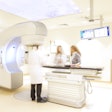
From the plastic surgeon's point of view, reconstructing an irradiated breast is hardly a simple nip and tuck. For example, studies have shown that the complication rate for a free transverse rectus abdominis myocutaneous (TRAM) flap procedure jumped from 21% to 33% for patients who had undergone postmastectomy radiation therapy.
Some of the postradiation changes in the breast include skin tightening, pigmentation changes, inflammation, thickening, fat necrosis, and tissue loss. These, and others limitations, can adversely affect the aesthetics of reconstruction outcomes.
Still, radiation therapy is here to stay, prompting plastic surgeons to figure out ways to most effectively reconstruct the irradiated breast. At the 2006 American Society of Plastic Surgeons (ASPS) meeting in San Francisco, four physicians shared their thoughts on working with these patients.
Before or after radiotherapy?
For patients who need postmastectomy radiation therapy, the optimal timing of TRAM flap reconstruction is controversial. But a 300-patient review conducted at the M. D. Anderson Cancer Center in Houston determined that delayed reconstruction was the way to go.
During the study period, 32 patients had immediate TRAM flap reconstruction (mean radiation dose of 50 Gy) before radiation therapy, and 70 patients had the reconstruction procedure after radiation therapy (51 Gy mean dose).
The researchers found that the incidence of late complications was significantly higher in the immediate reconstruction group than in the delayed reconstruction group (87.5% versus 8.6%), and that 28% in the immediate reconstruction group required an additional flap to correct the distorted contour from flap shrinkage and severe flap contraction (Plastic and Reconstructive Surgery, July 2001, Vol. 108:1, pp. 78-82).
Dr. Glyn Evan Jones from Emory University in Atlanta told the ASPS audience that delaying reconstruction after radiation treatment was his modus operandi. He cited several studies that back up the delayed protocol.
Jones highlighted another paper by Dr. Steven Kronowitz and colleagues from M. D. Anderson that looked at 69 patients who underwent repair of a partial mastectomy defect and received radiation therapy. Fifty patients underwent immediate reconstruction before radiation and 19 underwent delayed reconstruction after radiation therapy.
The majority of those women who had immediate reconstruction underwent breast reduction (66%) followed by local tissue rearrangement (28%) and TRAM flaps (6%). The complication rate in this group was 26%.
In patients with delayed reconstruction, 42% had breast reduction, 32% had local tissue rearrangement, and 26% had TRAM flaps. The complication rate came in at 42%.
"In the setting of delayed reconstruction, the flap technique was associated with a lower complication rate than the other two techniques," the group wrote. "Fifty-seven percent of the immediate reconstructions performed with the local tissue rearrangement or breast reduction technique, but only 33 percent of the immediate reconstructions performed with the flap technique, were associated with an excellent or good aesthetic outcome" (Plastic and Reconstructive Surgery, January 2006, Vol. 117:1, pp. 1-11).
Jones said that other studies have produced different results regarding the timing of reconstruction after radiotherapy, but he pointed out that the research was conducted by radiation oncologists and not plastic surgeons. One study, from the Mayo Clinic in Scottsdale, AZ, undertook a retrospective review to determine the effects of postoperative irradiation on TRAM flap viability and cosmesis, and concluded that TRAM flaps can be irradiated with few complications and acceptable cosmetic results (American Journal of Clinical Oncology, August 2004, Vol. 27:4, pp. 389-394).
Jones stressed that he would still urge patients and treating physicians to delay reconstruction until after the completion of radiotherapy.
"If radiation is planned, delay reconstruction," Jones said. "If there is no radiation planned, you can come back in a few weeks (for reconstruction). I would rather delay my reconstruction because of all the complications."
Expanders
In their ASPS meeting presentations, Dr. Neil Fine from Northwestern University in Chicago and Dr. Louis Bucky from the University of Pennsylvania in Philadelphia discussed why they rely on expanders. Uninflated tissue expanders are placed beneath the residual skin and muscle. Once the skin and muscle flaps have recovered from surgery, the implants are inflated, which also spares additional injury to the chest wall tissues. The expanders are often overinflated to create a more natural breast mound. Expanders can be outfitted with a plastic port through which radiotherapy is delivered.
For Fine, using expanders means giving himself and his patients more options. It also allows women to make a more informed decision about reconstructive surgery. Some women manage well with the expander before radiation and are interested in a more permanent implant once treatment is completed, he said. Others have a difficult time with the expander and decide against a permanent implant.
"(Patients) can see that this doesn't have to be a hurried decision," Fine said. "Using the expander gives us at least two chances to obtain the best results."
Bucky discussed some of the variables that must be considered for postradiation reconstruction: how radiation is delivered, type of expander, incision, and timing of exchange.
"We know that not all radiation (treatment) is the same," Bucky said. Treatment protocols will vary depending on the features of the cancer, tumor size, how close the margins are, and how many lymph nodes are involved, all of which can influence reconstruction, he said.
As for the type of expander, Bucky said he preferred a lower pole expander with an internal port for radiation delivery. He also favored an inframammary incision. With regard to the timing of the expander-implant exchange relative to radiation, Bucky said there were risk and rewards to two main approaches.
Putting in the expander, performing radiation treatment, increasing the expander volume, and then exchanging it for a permanent implant makes adjusting the tissue easier, but requires that the plastic surgeon operate on irradiated tissue, he explained.
"The alternative is to do all your expansions first, make your exchange, and then irradiate the implant," Bucky said. "The advantage is that you have less risk of extrusion, but there is no opportunity to adjust."
Delayed-immediate reconstruction
Dr. Steven Kronowitz started out his talk by stressing that there is no definitive way to tell if a patient will need radiation surgery -- at least not in a way that makes it easier for plastic surgeons to decide on a reconstruction plan.
"Although immediate reconstruction is ideal for many patients, there are two concerns that may impact postmastectomy radiation," Kronowitz said. "One concern might be that the reconstructed breast may impair the ability to give radiation. Another concern is that postmastectomy radiation may adversely affect the aesthetic outcome of immediate breast reconstruction."
At M. D. Anderson, Kronowitz and colleagues decide on a reconstruction strategy based on what category a patient falls into. First, the clinicopathologic factors used in the surgical decision-making for postmastectomy breast reconstruction are the following:
- Breast cancer stage
- Status of axillary sentinel lymph node
- Smoking status
- Body habitus
- Pre-existing scars
- Prior radiation therapy
- Planned or previous chemotherapy
The group suggested immediate breast reconstruction on patients who are at low risk for requiring radiation therapy after mastectomy (stage I). Delayed reconstruction may be preferable in patients who are deemed preoperatively to require radiation, generally at stage III (Cancer, September 1, 2006, Vol. 107:5, pp. 893-907).
But their go-to method in these patients is delayed-immediate reconstruction, Kronowitz said. This approach consists of two stages. In the first, skin-sparing mastectomy is performed with the insertion of a completely filled, textured saline tissue expander. Stage two is made up of two options. After pathological review, patients who do not require postmastectomy radiation therapy will have immediate reconstruction. Patients who required postmastectomy radiotherapy will complete their treatment, then undergo reconstruction (Plastic and Reconstructive Surgery, May 2004, Vol. 113:6, pp. 1617-1628).
"The primary advantage of this two-stage approach is to retain the aesthetic benefits of skin-sparing mastectomy and to avoid the difficulty associated with radiation delivery after reconstruction," Kronowitz said.
By Shalmali Pal
AuntMinnie.com staff writer
October 26, 2006
Related Reading
Breast implants require deft maneuvering for maximum mammo quality, October 11, 2006
Radiation helpful in women with ductal carcinoma in situ, September 27, 2006
Many women uncomfortable making breast cancer surgery decisions, August 4, 2006
Complications common with postmastectomy breast reconstruction, December 20, 2005
Copyright © 2006 AuntMinnie.com



















